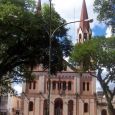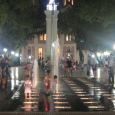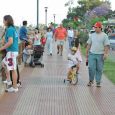Posadas
Advertisement
By Air
The General Jose de San Martín Airport (IATA: PSS, ICAO: SARP) is located 7.5 km northwest of the center of Posadas, a city in the Misiones Province of Argentina.The airport covers an area of 329 hectares and is operated by Aeropuertos Argentina 2000 S.A.It has a 6,500 m2 terminal and 67,740 m2 of runways and parking spaces for 100 vehicles.In 2007, it handled 65,019 passengers.At its peak in 1997, it handled 164,586 passengers.
By Train
Posadas is the end of the rail Ferrocarril General Urquiza, who communicates with the station Federico Lacroze of the Federal Capital.Posadas station is located at the end of the Madariaga Avenue, two blocks from historic downtown.Currently not working because it is located where it will place the final stretch of the waterfront of the city, which is under construction.The train now reaches the station Garupá City.It plans to build the new station Posadas about three blocks south of the international bridge.
By Bus
The bus service long and middle distance focuses on the modern bus terminal in the city, located in Quaranta Avenue (Route 12) and Santa Catalina Avenue.In long distance there are daily services to almost all the capitals and major cities and even some major cities in Paraguay, Uruguay, Chile and southern Brazil.As for the middle-distance service there several times a day service to many cities within the province of Misiones and Corrientes Northeast, because the towns in this region Ituzaingo, Playadito, Virasoro, Garrucha, Sao Tome, etc. are more related to Posadas Apostles and the city of Corrientes.Urban transport is formed by numerous bus lines that make up the so-called Integrated Transport System (which mimics the existing one in the city of Curitiba, Brazil) which consists of modern art articulated units that connects the downtown with neighborhoods and cities of the Great Inns.There is also a large number of taxis and remises.
Estudiantina Carnival
One of the main events is the Estudiantina, similar to a carnival celebration but organized in late September for high school students to commemorate the day the student.Floats, bands and dance troupe of samba music or Scola pass in a parade along Avenida Costanera delight with his dancing, brightness and design to local and foreign large population that adds to the festivities.The Queen of Estudiantina devotes almost every year as the Queen provincial, and on numerous occasions was elected as National Queen.In the decade of 1950 was beginning to celebrate the now famous Estudiantina Posadas.At first the party was limited to the parade of floats, which was presented the queen of each school.Today, organized by the Association of Secondary School Students Posadas (APES), the groups appear to be more successful than the same floats.For several nights shine creativity, enthusiasm and joy.Thousands of high school students make up the corps de ballet, rhythmic groups, marching bands and floats.The festival brings together several thousand people, who delight to the passage of several groups.
Jesuit Ruins in Misiones
the Jesuit ruins in San Ignacio Miní.We learned about its history, its days of glory and its subsequent disappearance.Take a tour around the beginnings of the new world.The day after we enjoyed the natural show of the Iguazu Waterfalls, we traveled inland in the Province of Misiones.This time we visited the famous Jesuit ruins of San Ignacio Mini, declared World Heritage by UNESCO in 1984.We set out with great expectations.We would be visiting one of the most emblematic reductions in America, the one featuring the best restoration conditions as compared with other reductions in the Order.We already knew that the aim of this mission was to evangelize the Guarani natives.After traveling along National Route 12 for three hours heading Southwards, we arrived at the village of San Ignacio, where the ruins are located.We paid for the entrance ticket and we entered the mission that gives testimony of the labor done by the Jesuits, where the native culture once mingled with the European heritage without any kind of violence.Today, only vestiges remain of a settlement where science and art were part of the union between the white man and the guaraní people.
Anibal Cambas Regional Museum
Housed by an old building featuring English style and a brick facade dating back from 1882, it has been named after one of the founders of the Board of Historical Studies of Misiones, don Anibal Cambas.This regional museum has only one room divided into three sections where visitors may find archeological, biological and historical elements of the Province of Misiones.The Julio Cesar Sanchez Ratti section contains material about the pre-history of Misiones, from 7,000 to 10,000 BC, with elements of the formation stage.Another area inside the same section features ethnographic, pre-Jesuit and historical objects such as weapons used in the Triple Alliance War, back in 1865.The second section, called Felix de Azara, displays regional fauna, with a particular emphasis on the endangered species.Besides, materials that once belonged to the guayaqui, guarani, chiripa and mbya cultures are also on display.It is important to highlight the presence of funerary urns known as yapepos made by hand, in which the natives would bury the dead with grave goods.Lastly, Clotilde Gonzalez de Fernandez Ramos Library contains books of Argentinian and regional history, as well as a noteworthy photographic archive.
Manuel Antonia Ramirez Amphitheater
Rooted in the heart of Posadas, the construction of the amphitheater due to a sports need since Posadas had agreed to host the National Championship of Basketball, Ball, 1962.In recent years it has been host to various festivals and shows including the National Festival of Music of the Coast, and Estudiantina.With a capacity for 4,000 people, this balcony, gives the feeling of opening for endless imaginary journeys through the Parana River, running behind him and feeding of fresh air to the city.The mastermind behind the name "Manuel Antonio Ramirez" granted to the amphitheater, was the Chairman of the Board of Historical Studies, Don Anibal Cambas.The then Governor had made a personal consultation about it, with the only requirement that was the name of a missionary representative, Anibal Cambas asked to think about it 24 hours and returned with the identification of the "poet of Missions," as it is known.Intellectual born, Manuel A. Ramirez was born in Buenos Aires in 1911, graduated as an agronomist in 1930 and devoted himself to journalism missions.
June - November
January - March






